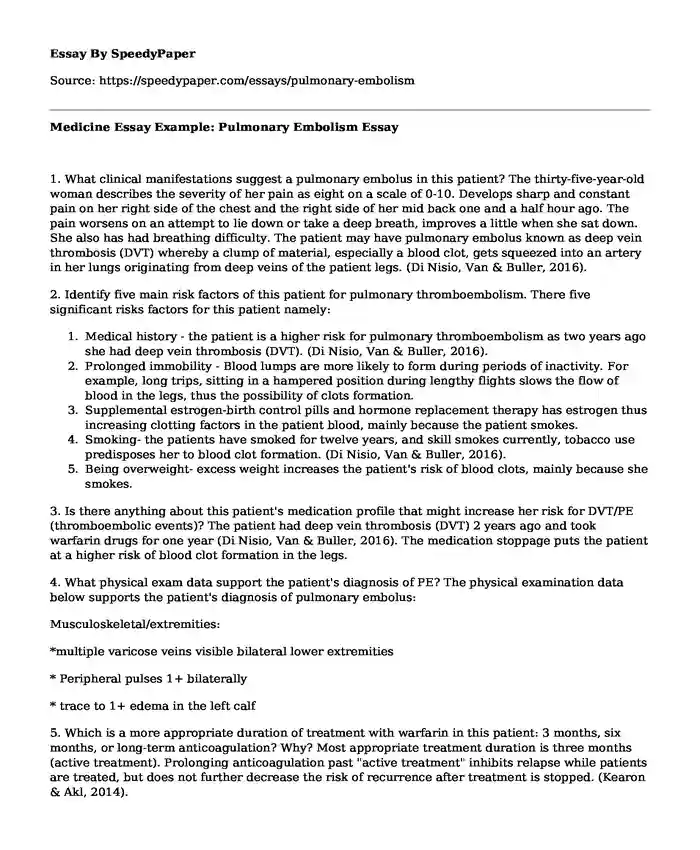1. What clinical manifestations suggest a pulmonary embolus in this patient? The thirty-five-year-old woman describes the severity of her pain as eight on a scale of 0-10. Develops sharp and constant pain on her right side of the chest and the right side of her mid back one and a half hour ago. The pain worsens on an attempt to lie down or take a deep breath, improves a little when she sat down. She also has had breathing difficulty. The patient may have pulmonary embolus known as deep vein thrombosis (DVT) whereby a clump of material, especially a blood clot, gets squeezed into an artery in her lungs originating from deep veins of the patient legs. (Di Nisio, Van & Buller, 2016).
2. Identify five main risk factors of this patient for pulmonary thromboembolism. There five significant risks factors for this patient namely:
- Medical history - the patient is a higher risk for pulmonary thromboembolism as two years ago she had deep vein thrombosis (DVT). (Di Nisio, Van & Buller, 2016).
- Prolonged immobility - Blood lumps are more likely to form during periods of inactivity. For example, long trips, sitting in a hampered position during lengthy flights slows the flow of blood in the legs, thus the possibility of clots formation.
- Supplemental estrogen-birth control pills and hormone replacement therapy has estrogen thus increasing clotting factors in the patient blood, mainly because the patient smokes.
- Smoking- the patients have smoked for twelve years, and skill smokes currently, tobacco use predisposes her to blood clot formation. (Di Nisio, Van & Buller, 2016).
- Being overweight- excess weight increases the patient's risk of blood clots, mainly because she smokes.
3. Is there anything about this patient's medication profile that might increase her risk for DVT/PE (thromboembolic events)? The patient had deep vein thrombosis (DVT) 2 years ago and took warfarin drugs for one year (Di Nisio, Van & Buller, 2016). The medication stoppage puts the patient at a higher risk of blood clot formation in the legs.
4. What physical exam data support the patient's diagnosis of PE? The physical examination data below supports the patient's diagnosis of pulmonary embolus:
Musculoskeletal/extremities:
*multiple varicose veins visible bilateral lower extremities
* Peripheral pulses 1+ bilaterally
* trace to 1+ edema in the left calf
5. Which is a more appropriate duration of treatment with warfarin in this patient: 3 months, six months, or long-term anticoagulation? Why? Most appropriate treatment duration is three months (active treatment). Prolonging anticoagulation past "active treatment" inhibits relapse while patients are treated, but does not further decrease the risk of recurrence after treatment is stopped. (Kearon & Akl, 2014).
6. Which clinical finding provides the most persuasive evidence of pulmonary embolus in this patient? The following findings provide strong evidence of PE in the patient:
V/Q Scan:
*Perfusion defect at right base. Some mismatch between perfusion abnormality and ventilation of right lung.
7. Discuss three priority problems in the care of this patient, your rationale for choosing these problems and 3 or more interventions for each of the problem areas.
Deep vein thrombosis (DVT): to prevent the blood clot from moving to the arteries in the lungs the nurses should adopt Heparin- initial therapy used to break up the clot. Also to prevent future blood clots transition into a SubQ or oral anticoagulant. SubQ or oral anticoagulant breaks up blood clots and also well as inhibits them. Lastly, monitor aPPT or Anti-Xa Q6H to adjust and maintain therapeutic levels.
Heart attack: to prevent the patient from having a heart attack, she experiences severe chest pain and breathing difficulty, the nurse should continuously monitor her using 3 or 5 lead cardiac for pulse oximetry. Furthermore, assess and watch for potential complications d/t the blood clot moving into another area like the lungs (PE). (Allen & Proctor et al., 2016)
Hypertension: the patient's father has hypertension putting his daughter the patient at risk getting the disorder. The nurse should monitor the patient carefully, encourage the patient, make sure she takes his medication (Alprazolam 0.5 mg PO Q8hr PRN for anxiety) and rests well.
References
Allen, C. J., Murray, C. R., Meizoso, J. P., Ginzburg, E., Schulman, C. I., Lineen, E. B., ... & Proctor, K. G. (2016). Surveillance and early management of deep vein thrombosis decrease the rate of pulmonary embolism in high-risk trauma patients. Journal of the American College of Surgeons, 222(1), 65-72.
Di Nisio, M., van Es, N., & Buller, H. R. (2016). Deep vein thrombosis and pulmonary embolism. The Lancet, 388(10063), 3060-3073.
Kearon, C., & Akl, E. A. (2014). Duration of anticoagulant therapy for deep vein thrombosis and pulmonary embolism. Blood, blood-2013.
Cite this page
Medicine Essay Example: Pulmonary Embolism. (2022, Aug 25). Retrieved from https://speedypaper.net/essays/pulmonary-embolism
Request Removal
If you are the original author of this essay and no longer wish to have it published on the SpeedyPaper website, please click below to request its removal:
- Racial Bullying in Schools, Free Essay
- Free Essay on Chronic Obstructive Pulmonary Disease (COPD)
- Free Essay about Information Sharing in Teams
- Essay Example on Immigration and Its Effects
- Free Essay: The Unified Theory of Acceptance and Use Theory (UTAUT)
- Business Valuation: Estimating the Economic Value of a Company
- Essay Sample on Utilizing Frames and Key Messages
Popular categories





